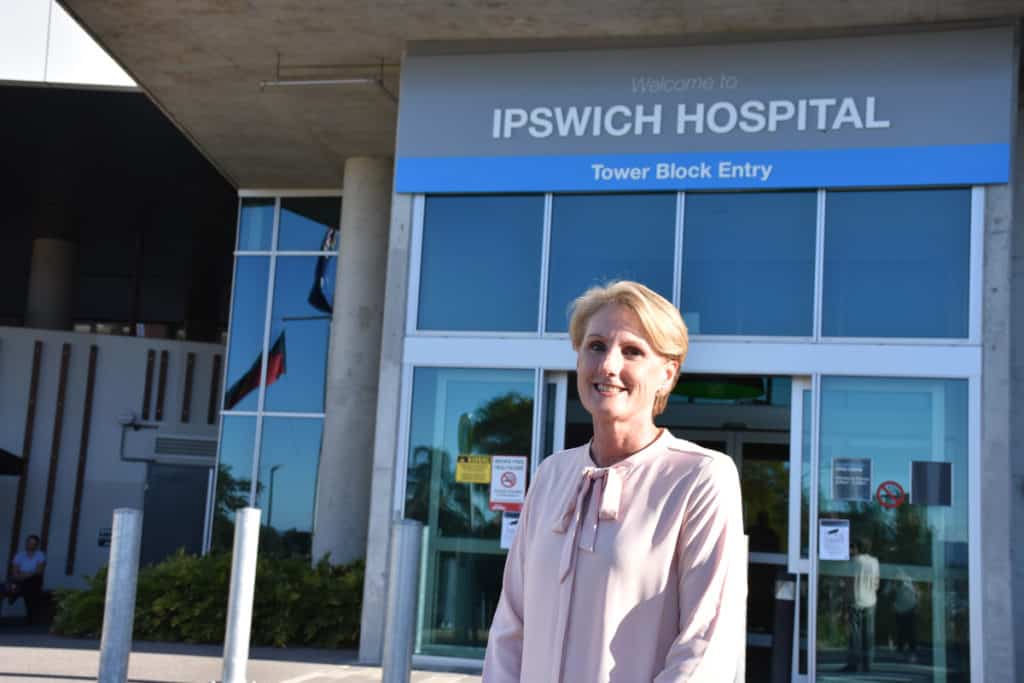West Moreton Health nurse navigator Gail Rogers swapped the familiar wards of Ipswich Hospital for a 1000-bed hospital on the high seas during a recent seven-week deployment with the Navy.
Gail Rogers is a Lieutenant Nursing Officer in the Royal Australian Navy Reserves. She recently answered a call to board the USNS Mercy, an American Navy hospital ship, as part of a humanitarian mission in South East Asia.
Swapping her walk up the hill to the Ipswich Hospital with walking through the rolling passageways aboard a 270m hospital ship, for Ms Rogers there was no average day.
“I would be up at 4.30am to join an exercise class then head to breakfast before showers and off to work. We worked 12 hour days from 7am to 7pm,” Ms Rogers said.
“When you are underway at sea everything is different. Even transferring a patient on the trolley is very different. The boat is rocking so you have to account for that. Everything has to be secured.
Gail Rogers (second left) manning the rails as she left Sri Lanka.
Managed by the United States Navy, USNS Mercy primarily operates in the Pacific and Indian Oceans. It is the biggest Hospital Ship in the world. Video courtesy of US Defense News.
“All the beds are tied down to the floor, the cupboards have special locks on them so they don’t fly open and you must never leave anything on top of benches.”
After boarding in Kuala Lumpur, the ship set sail for Sri Lanka and later docked in Vietnam and Japan.
“I worked in Casualty Receiving on board the ship, looking after any injured or emergency patients,” Ms Rogers said
“We were also responsible for screening any interpreters and patients who came aboard for TB (tuberculosis) and head lice.”
When the ship docked, Ms Rogers said they also set up clinics in local hospitals to screen patients for general surgery or cataract surgery. At other times they set up general practice clinics in local schools where they provided health care, optometry, audiology, pharmacy, physiotherapy and dental care to the locals who presented.
“There were often hundreds of people turning up every day, and we were unable to see them all.”
While they were at sea Mr Rogers took part in a mass casualty drill that involved bringing a patient in by helicopter.
“We were prepared for different types of emergency presentation, maritime type accidents such as drowning, kitchen accidents like oil exploding, so burns.” Ms Rogers said.
“The ship has to be steady enough for the helicopter to land, the external part of the ship is closed so we have to wait inside.”
When the patient was in emergency, Ms Rogers had to adapt to the different way the US handles medical procedures.
“In Australia, the nurse would draw up all the medicine for pharmacy to prepare, but on the ship, the pharmacy does this, also a lot of the medication have different names to ours,” she said.
“I really enjoyed working alongside others and getting their view.”
USNS Mercy routinely tours the Asia Pacific region as part of the Pacific Partnerships Humanitarian Mission, which was set up following the December 2004 tsunami which devastated parts of the region. The mission coordinates joint health care, veterinarian and engineering works to assist local communities and is also used to prepare for potential humanitarian and disaster responses.
The hospital ship has 12 operating theatres and a surgical robot to facilitate complex surgery. It also has an 80-bed Intensive Care Unit, medical imaging, a blood bank, emergency department and medical and surgical wards.
“It was a fantastic opportunity and I feel very blessed to have been given the opportunity to be involved,” Ms Rogers said.
“It was also a reminder of how lucky we are to have the Australian health system and I am grateful that I live in Australia with our access and provision of health care.”

